|
|
Volvo S60 / V60
|
 |
|
|
Debut: 2010
Maker: Volvo
Predecessor:
S60 Mk1
|
|
|
|
| Published
on 6
Jun
2010 |
All rights reserved.
|
|
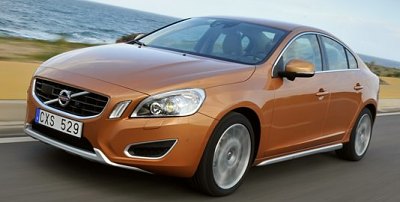
|
Claimed to offer one of the best
dynamics of its class, will the S60 be just too Germanic ?
|
This is the second
generation Volvo S60. The Swedish manufacturer boldly claims it has one
of the best driving dynamics of its class, which comprises BMW
3-series, Mercedes C-class and Audi A4, among others. I repeat: one of
the best driving dynamics of the class. Can you believe this is a Volvo
?
Frankly, such a claim worries me. Volvo appeals to me because of its
Scandinavian flavour - simple yet elegant, well-built without
flamboyant, ergonomical, practical, reliable and safe. The last thing I
would want Volvo to be is to drive like a BMW or Audi. If so, Volvo
would be no longer Volvo, and we would have no reasons to buy it
anymore. However, I don't think many people share my appreciation for
auto-diversity. These days most people seemed to bias towards the
"advant-garde sportiness" of BMW and Audi. Anything else are difficult
to register big sales numbers. This forced Volvo - as well as Mercedes,
Jaguar, Saab, Opel and Ford - to follow suit.
Volvo's migration towards the sporty route started 9 years ago with the
first generation S60. It was designed as a stylish four-door coupe
(well before Mercedes did the same thing to its CLS). It received
sportier chassis tuning than any previous Volvos. However, limited by
the S80 platform on which it was based, it never quite matched its
German
rivals for performance and handling.

|
How is it possible for the coupe shape
not to compromise rear seat space ?
|
This time is different. Although the
new S60 is built on the EUCD platform of V70, S80 and Ford Mondeo, it
was allowed to make extensive changes to the chassis. For example, its
front subframe has been made much stiffer than the ones in other
versions of EUCD platform. Its front strut mounts and suspension
bushings are also stiffer. Larger diameter dampers contributes further
to rigidity. As a result, its front suspensions are more resistant to
distortion due to cornering g-force and road shocks, keeping their
geometry close to ideal case in maneuvering. Besides, the steering
column and its mounting have been greatly stiffened so that kickback is
largely eliminated. This also allows the car to adopt a 10-percent
faster steering rack to enhance sporty feel.
The pursuit of German sportiness goes further than a stiffer structure.
Mirroring BMW's M-sport, Audi's S-line and Mercedes' Avant-garde
suspensions, the new Volvo allows customers to choose between two
suspension packages - the softer Touring or the stiffer Dynamic. The
former takes care of traditional Volvo customers whereas the latter is
designed to lure younger drivers from the German camp. Of course,
customers with deeper wallets may enjoy the best of both worlds by
opting for Four-C continuous adaptive damping, which is carried over
from the old car. This device provides you three distinctive modes -
Comfort, Sport or Advanced, one harder than another.
No matter how hard the aforementioned efforts are, Volvo S60 is still a
front-wheel drive machine suspended on unsophisticated MacPherson
struts up front, so how to tame its understeer and torque steer becomes
critical. As before, AWD is standard on the most powerful (300hp-plus)
T6 and optional on some other models. It continues to utilize a
Swedish-built Haldex multi-plate clutch to transfer torque from the
front axle to the rear axle in case of slippage. In addition, another
multi-plate clutch device now provides torque vectoring between the two
rear wheels. This should greatly reduce understeer at the limit. For
those cannot afford the AWD system, don't worry, the new S60 has added
Corner Traction Control, which is a brake-actuated electronic
differential lock. Another new feature is Advanced Stablity Control.
Compare with existing ESP systems, Advanced Stability Control adds a
body roll sensor, thus it can react earlier and more progressively,
suppressing understeer more naturally.
 |
EUCD platform is stiffest in this form
|
The sporty theme continues on its
exterior design. The new S60 was designed by Steve Mattin during his
short stint as Volvo's design chief. Mattin was previously responsible
for various Mercedes-Benz designs such as A-class, S-class, SL-class
and R-class. From these cars you can see his preference on radical
designs, no wonder the new Volvo looks so aggressive. Undoubtedly, it
is a head-turning design, but isn't it a little too flamboyant,
especially those headlights and alloy-effect underbody panels ?
Anyway, the new design does look attractive in the fresh, and it is
compatible with a good drag coefficient of 0.28. The "four-door coupe"
shape is preserved and enhanced further. The fast rear window seems to
compromise rear headroom, but in fact it does not. Yes, entering the
rear seats takes some precaution to avoid hitting the C-pillars, but
once entered, people up to 6 feet tall will find enough head and
leg room. How is this made possible ? If you compare the side profile
of the new car with the old one, you will find its wheelbase has been
stretched by 50mm, which contributes to 30mm extra rear knee room. Its
roof has been raised by 56 mm, the rear screen is set further back and
the combination of higher boot lid level and rising waist line also
contribute to visual sleekness without actually eating into cabin
space. Volkswagen Passat CC also uses a similar trick, but I would say
Volvo's execution is cleverer and the overall effect is more stylish.
Don't get me wrong, the S60 is no where as spacious as Ford Mondeo or
Skoda Octavia. Its interior space is just competitive against its
target rivals BMW 3-series, Audi A4 and Mercedes C-class. Like them, it
is better served as a 4-seater as the center rear seat cushion is
narrow and
hard.
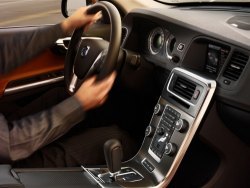 |
The interior design is easy on the
eyes. There is an air of quality and solidity yet the overall theme is
warm and understated. The trademark floating console is now angled
towards the driver. Above which is a built-in LCD screen, which has
become class norm. The screen is positioned high to avoid distracting
your vision from the road. The same cannot be said to the controls on
center stack, which are placed too much lower than eye level. Driving
position is excellent, whereas the chairs are supportive yet very
comfortable for long journey.
Safety has always been the strength of Volvo. Although other car makers
have largely closed the gap in the past few years, the S60 still has
one advantage - Pedestrian Detection system with Full Auto Brake. It
uses radar and camera to detect pedestrians in front of the car, then
warns the driver with beep and flash lights at the head-up display, and
simultaneously pre-charges the brake booster. If the driver fails to
react, it will brake the car to full stop automatically. As long as the
vehicle speed is no more than 35 km/h (22 mph), S60 can avoid hitting
the pedestrian. Above that speed, the system can still greatly reduce
impact force hence the injury caused to the pedestrian.
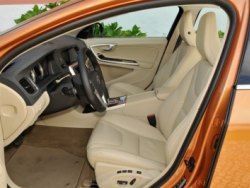 |
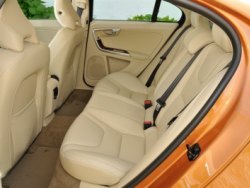 |
The engine range of S60 seem competitive. Although Volvo is now in the
hands of Chinese, it still gets the latest "Ecoboost" engines from
Ford. At the bottom of the range is 1.6 GTDi in two states of tune
(150hp or 180hp). Both employ full variable valve timing, direct
injection and turbocharger. The same technology can be found on the two
2.0 GTDi engines that produce either 203hp or 240hp. We have seen the
lower power version in Ford Mondeo and it impressed us with good
response and linear power delivery. The higher power version is not
available at the time of writing. It will be badged as T5 and serve as
a greener
replacement to the long-serving Volvo five-pot engines.
The characterful five-pot still lives in the form of diesel. The
2.4-liter D5 employs a sequential twin-turbo system with different size
turbines to achieve 205 horsepower at minimum lag. Its problem is
excessive noise under hard acceleration, so the entry-level D3 may be a
better choice. The latter is downsized to 2.0 liters, employs a
conventional VTG turbo and produces 163hp. It loses little real-world
performance to the larger engine because its maximum torque is only 15
lb-ft down.

|
Dynamically, see it as a beefed up
Ford Mondeo and it won't be far off...
|
At the top of the range is T6, powered
by Ford's turbocharged 3.0-liter straight-six built in Wales. Thanks to
reduced internal friction, its output is lifted from 285hp on V70 / S80
to 304hp here. Its maximum torque is 30 lb-ft higher than that of BMW
335i.
All these sound promising. However, on the road the S60 never feels as
quick as it should be. One of the reasons is its hefty weight - in
front-wheel-drive form it tips the scale at about 100 kg more than a
3-series or C-class, or close to 200 kg in the case of T6 AWD.
Moreover, the Aisin-built Geartronic 6-speed automatic transmission is
not quite the best around, no matter response or efficiency. A narrower
ratio spread means the cars with Geartronic return significantly higher
fuel consumption and carbon emission than those with manual gearbox.
Worse still, Geartronic is compulsory on the T6, whereas most other
S60s are also likely to be sold with Geartronic.
Dynamically, the S60 isn't in the league of BMW and Mercedes yet, but
it has taken a leap forward and is now on a par with Audi. See it as a
beefed up Ford Mondeo and it won't be far off. Its chassis feels solid
and is reasonably well balanced. Its body control is tidy. AWD provides
plenty of traction and grip. Torque vectoring improves its agility at
the extremis, though in normal driving it still feels nose-led. Its
biggest weakness is steering, which is too light and numb. On the
positive side, the S60 will be praised for a refined ride. Even on
optional 18-inch wheels and 40-section tires it still leaves enough
compliance on any surfaces - the same cannot be said to its German
rivals with sports suspensions. Meanwhile, the float of the old car has
been replaced with great body control, which translates into high level
of composure. The lack of road and wind noise enhance the refinement
further.
Well, its claim for best-in-class driving dynamics might be a bit over
the
top, but so what ? The most important is, while pursuing a sportier
taste, the Volvo has not forgotten what made it special and successful
in the past, i.e. comfort, refinement and safety. This is definitely
one of the cars entry-level executive cars buyers have to consider. |
Verdict:     |
Published on 1
Oct 2011
|
All rights reserved.
|
|
S60 R-Design
|
|

Originally, R-Design is
supposed to be a sporty look and suspension trim level at Volvo, just
like BMW's M Sport package or Audi's S-line package. The S60 R-Design
in Europe gets a more aggressive looking (if not functioning) front air
dam and rear diffuser and a set of 18-inch wheels shod with 235/40
rubbers to distinguish from the regular trims. In addition, its
suspensions are considerably stiffened, with 15 percent stiffer
springs, 15 mm lower ride height, thicker anti-roll bars, stiffer
bushings and a front tower bar to reinforce the structure. Regardless
of models, sportier passive dampers replace the Four-C adaptive
dampers. Inside, the cabin gets unique steering wheel, gear lever,
pedals and trim materials. Normally, I don't write about such modest
changes.
Unlike Europe, Volvo USA wants to give the R-Design label a real
performance meaning so that it has something to rival Audi S4 and BMW
335i. Therefore, the US version of S60 R-Design is not only limited to
the flagship T6 powertrain – which means 4-wheel-drive and turbocharged
3.0 straight-six – but it also enjoys a slight power boost. Turbo boost
pressure is dialed up from 0.9 to 1.0 bar, lifting output by 25 hp and
30 lbft to 325 hp and 354 lbft. As the boost is modest, it needs no
more than a revised ECU. No worry about hurting durability, as the same
tuning has been well proven by Volvo's semi-official tuning arm
Polestar.
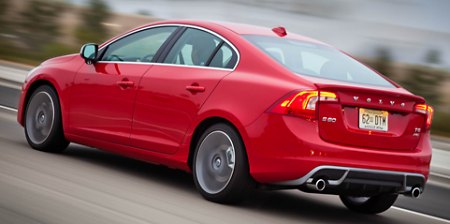
The result is just as expected: a marginally faster and sharper S60.
Its acceleration still can't match the aforementioned German rivals,
mostly due to its immense weight of 1738 kg. The steering response and
body control are better than the regular T6, but the chassis still
feels front-heavy compare with the aforementioned German rivals, while
the unchanged brakes are not
up to the job of performance saloon. The electrohydraulic steering gets
heavier but no more feelsome, sadly. On the plus side, the firmer ride
is still smooth enough, and the cabin remains well insulated from noise
sources.
Being promoted as a performance saloon, the US version S60 R-Design is
inevitably disappointed. Its charm remains the same as the regular
versions of S60, i.e. a combination of high refinement, unique style
and trustable safety. This mean the best S60 is not the performance
flagship model but the cheaper ones. |
Verdict:    |
Published
on 25
Jun 2013
|
All rights reserved.
|
|
V60 Plug-in Hybrid
|
|
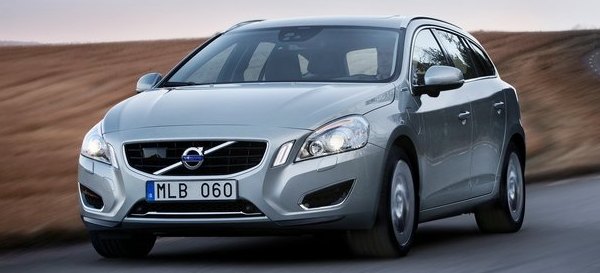
|
Volvo V60 Plug-in Hybrid is
neither the first Plug-in hybrid car (that was BYD F3DM) nor the first
diesel hybrid (i.e. Peugeot 3008 Hybrid4), but it is the first
combining the best of the two. Under the bonnet is exactly the same
2.4-liter turbo diesel inline-5 as the regular V60 D5, which drives the
front wheels only. At the rear axle, there is an 11.2 kWh lithium-ion
battery pack and an electric motor that drives the rear axle. The
battery is large enough to offer a pure electric driving range of 50 km
(31 miles) if you are light on throttle. That means, for your regular
commutes between home and supermarket, you don't even need to fire the
engine once if the battery is fully charged at home. For longer
journey, the car drives much more like conventional hybrids, but still
its diesel engine should give better combination of fuel economy and
real-world performance.
And what a performance. The V60 Plug-in Hybrid sprints from rest to 60
mph in just over 6 seconds. Its diesel engine produces 215 hp and 324
lbft of torque, while the motor supplies another 67 hp and 147 lbft. As
the power and torque curves of diesel engine and electric motor match
each other very well, the total is simply the sum of the two, i.e. 282
hp and 471 lbft. Admittedly, a large part of the electric power is used
to offset the extra weight of 300 kg (including 150 kg of battery).
Still, we can't think of any other non-electric cars in the world can
do 0-60 mph in 6 seconds yet achieve an EU fuel economy of 155 mpg and
carbon-dioxide emission of just 48 grams every kilometer. Mind you, the
EU figures are somewhat deceived by the energy stored in the battery
before test. However, in real world road test the Volvo can still
easily beat the diesel BMW 330d, Audi A4 3.0TDI and Mercedes C300CDI
for fuel consumption.

|
Volvo is wise to take the V60 as the basis of the
technology, because its larger cargo room can afford the loss of 125
liters due to the battery. Inevitably, the extra weight causes its
handling to feel less agile, but for a Volvo that is not a fatal fault.
Most important to its buyers, it remains to be a solid, stable, refined
and safe handling car.
The e-4WD concept is similar to Peugeot's Hybrid4. In zero emission
mode, the car is RWD. In contrast, power mode engages both engine and
motor to deliver maximum propulsion while the car is driven by all
wheels. You can also deliberately engage 4WD mode if you need the extra
traction it provides, say, to tow heavy load. However, most of the time
the car is likely to operate in hybrid mode, where computer decide
which power source to engage depending on power needs and battery level.
The drawback is price. Powerful diesel engine is expensive, even more
so is the hybrid system, especially the large lithium battery that
plug-in hybrid needs. As a result, the V60 Plug-in Hybrid costs 20-25
percent more than the regular V60 D5. Fortunately, a large part of the
premium can be offset by government grant and tax cut in many
countries, while the rest could be recouped from the fuel saving. Volvo
developed the car at a budget of £280 million, half of which was
subsidized by Swedish power company Vattenfall, therefore it is
unlikely to lose money.
|
Verdict:     |
Published
on 3
Oct 2013
|
All rights reserved.
|
|
S60 / V60 with Drive-E engines
|
|

|
In the past decade Volvo
has been relying heavily on engines supplied by Ford. These include the
1.6 and 2.0 turbo four, 3.0 turbo straight-six as well as the Ford-PSA
1.6 and 2.0 turbo diesel. When Ford sold Volvo to Geely in 2010, it
agreed to continue supplying engines for a few more years. However, in
longer term the prospect is not so clear. Even if it manages to have
the contract renewed, the prices won't be as favourable. Therefore,
Volvo decided to build its own engines again. Being a relatively low
volume manufacturer, it could not afford to develop a full range of
small and large engines like BMW or Mercedes. To reduce development and
production costs, it made a brave decision to equip all its future cars
with the same family of four-cylinder engines, abandoning the trademark
straight-5 and the T6 straight-six engines it is now using. This will
happen within 2 years. It might sound terrible, but those old enough to
remember the pre-PRV era (up to the early 1980s) might say an
all-four-cylinder Volvo lineup would not hurt its image the slightest.
On the contrary, it might bring a clearer message about green and
practical.
To rebuild its own powertrain R&D expertise must be challenging.
After all, Volvo had practically stopped developing new engines for a
decade. Fortunately, veteran powertrain boss Derek Crabb is still there
(he must be bored by the daily work of tuning, adapting and certifying
engines in the past few years). With budget assigned, he rebuilt the
development team and facility in Gothenburg. Meanwhile, the engine
plant in Skovde that is still building the 5-cylinder engines has a lot
of unused capacity. Eventually, it will build 500,000 four-cylinder
engines annually.
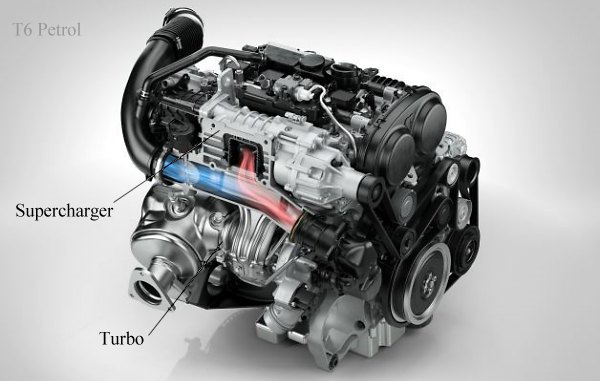
|
The new Drive-E engine family is unusual. It includes both
petrol and diesel versions, sharing the same aluminum block but with
different heads, reciprocating parts, exhausts and fuel systems etc. It
will eventually have 8 variants with output spanning from 120 hp to 306
hp, but all versions will displace the same 1969 c.c. This can be
achieved by different kinds of forced induction.
The petrol engines feature direct injection, high-speed continuous
variable valve timing, friction-reducing ball-bearing on camshafts and
on-demand variable water cooling system. The first production versions
produce 245 hp and 258 lbft on T5 models, or 306 hp and 295 lbft on T6.
The former employs a single twin-scroll turbo, while the latter uses
both a supercharger (which works at low rev) and a large turbo (takes
over at 3500 rpm) like Volkswagen's Twincharger. This guarantees an
excellent low-end response and simultaneously very high output. It
matches nearly the current 3.0 turbo six but returns much better fuel
economy (44.1 mpg versus 28.5 mpg EU combined) and remarkably low
emission (149 g/km vs 231 g/km) on the new S60 T6. Thanks to reduced
weight and a new Aisin automatic transmission with 8 ratios instead of
6, performance is also improved.
The diesel engine employs different-size sequential twin-turbo (small
one for low rev and large one for high rev) like Volvo's existing
diesel 5-pot, but what really shines is its innovative i-Art
common-rail injection system, which not only works at a record-high
2500 bar of fuel pressure (500 bar higher than the latest rivals) but
also has individual microprocessor, pressure sensor and injection
actuator on each cylinder to precisely control the amount of fuel
injected into each cylinder. The first version produces 181 hp and 295
lbft of torque and serves D4 models. Remarkably, it returns 67 mpg on
the combined cycle and emits only 99 grams of CO2
on the S60 D4 manual.
These figures are even better than BMW 320d EfficientDynamics while its
performance is also stronger. Transmission is either 6-speed manual or
that Aisin 8-speed auto.
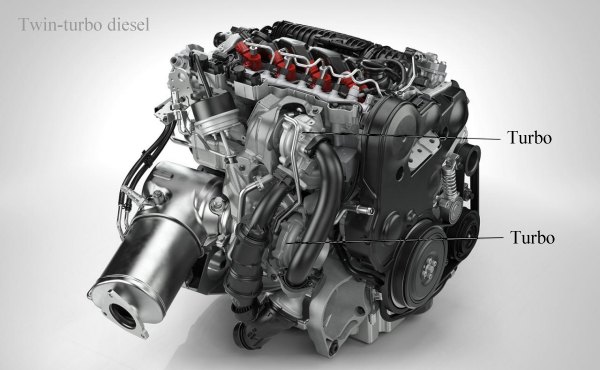 |
In the real world, the D4 diesel engine is quite noisy at high rev,
blame to the aluminum block that it shares with the petrol variants.
However, it is pretty smooth and responsive. Thanks to the sequential
twin-turbo, the torque spread is much more linear than the old
2.0-liter five-cylinder D4. The petrol T6 engine is also responsive and
refined. Its transition between supercharger and turbo is nearly
imperceptible. The power is abundant, but asking it to rival the turbo
straight-six of BMW 335i or supercharged V6 of Audi S4 is just too
much, because it lacks the low-end punch and the sound quality of its
6-cylinder rivals. It sounds stressed under push, and doesn't rev quite
as creamy smooth. After all, a remarkable four-cylinder engine is still
a four-cylinder. Besides, the Aisin 8-speed gearbox is not as
responsive as its rivals' ZF auto, taking some edges off the
acceleration.
The T6 is now available in front-wheel drive, but it does not employ
any mechanical or active LSD to tame the power. Instead, it gets a more
sophisticated
traction control which alters fuel injection to cut power. This works
reasonably well in practice, but the rest of the S60 chassis is not up
to the job. Its suspension is over-firm at low speed and a bit floaty
at higher speeds. The steering remains lifeless. The front-drive
chassis is not as agile as its premium rivals. Understeer and body roll
are more pronounced. Even though the Drive-E engine is lighter, the S60
shows little improvement in ride and handling. Perhaps Volvo needs to
spend more time on the chassis tuning. Just a good new engine is not
enough to make the S60 a class leader, although I still prefer its
styling and interior.
|
Verdict:     |
Published
on 23
Apr 2014
|
All rights reserved.
|
|
S60 / V60 Polestar
|
|

|
Volvo does not operate a
performance division like BMW’s M or Mercedes’ AMG, but it has an
official motor racing partner, Polestar, which started tuning Volvo
road cars in recent years. The S60 and V60 Polestar are the first joint
projects between the two firms. Their engineering and modifications
were carried out by Polestar, while Volvo supports the production and
is
responsible for sales and marketing. Only 750 units of each model will
be built, and their presence will be confined in 7 countries, i.e.
Sweden, UK, the Netherlands, USA, Canada, Australia and Japan. It is a
small-scale experiment but the meaning could be big. If the partnership
goes
well, Polestar could be developed into the AMG of Volvo!
Derived from S60/V60 T6 R-Design, the Polestar models seem not to be
very
promising. Why? Because the T6 R-Design is seriously
overweight at more than 1700 kg. Its nose is burdened with a
transversely mounted 3-liter straight-six which hampers its agility.
The single-turbo, port-injection straight-six is neither the most
advanced nor the most willing of its kind, and its supplier Ford (the
former owner of Volvo) is reluctant to update it. Still,
Polestar did a respectable job to improve it. It gives the engine a
larger
twin-scroll turbo to lift the boost pressure from 1.0 to 1.2 bar. It
also changes to a larger intercooler and large-bore stainless steel
exhaust so that peak power and torque are lifted to 350 hp and 369 lbft
respectively, whereas the extra flap in the exhaust system opens to a
sporty howl at higher rev. Unsurprisingly, the old 6-speed automatic
gearbox is
retained, but Polestar remapped it to give faster gearshifts in
sport/manual mode and adds
the function of launch control. As a result, the 0-60 mph sprint is
quickened to 4.7 seconds in the case of S60 or 4.8 seconds for the
wagon. Compared with T6 R-Design, that’s an improvement of 0.8 second.
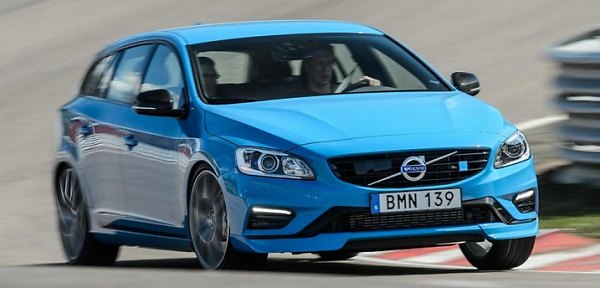
|
Unfortunately, while such performance level matches BMW 335i and Audi
S4, the Polestars are sold at a price level closer to M3 and RS4! To an
unestablished performance brand this is absolutely nonsense. The only
excuse is their rarity, but even with that in mind it is hard to
persuade car enthusiasts to invest into the Volvos instead of the very
desirable German cars, unless the Polestars ride and handle like a
dream…
Well, they are not exactly a dream, but considering their mediocre
basis the
result can be described as a miracle. Polestar retuned the Haldex 5 AWD
system to
be more rear-biased in corners. It also overhauled the suspensions with
80 percent stiffer springs, 15 percent stiffer anti-roll bars, harder
bushings and, most important, a set of racing-style Ohlins shock
absorbers,
whose dual-flow-valve technology allows 3 ways of oil flow for both
compression and rebound to suit different speeds of impact. Besides,
the larger 20-inch wheels are shod with grippier, 245/30ZR20 Michelin
Pilot Super Sports and house larger, 371 mm front disc brakes with
Brembo 6-pot calipers. Lastly, the chassis is reinforced with a
carbon-fiber strut brace. Outside, deeper lip spoilers and extra boot
spoiler cuts aerodynamic lift.
On the road, its ride and handling are really transformed. Despite of
the absence of electronic adaptive damping, the sophisticated Ohlins
dampers are surprisingly absorbent over a variety of road
irregularities, including speed bumps on highway, larger bumps on
country roads and large ridges in town, keeping the ride fairly
composed. This suits the Volvo’s role as a long-distance express. They
also deal easily with mid-corner bumps thus the car remains
impressively stable in the twisty. Meanwhile, the stiff springs and
anti-roll bars keep body roll well in check. They also make the
unaltered steering feels sharper and more responsive to your commands.
The grip and the brakes are up to the job, too. The chassis tuning of
Polestar hits the sweet spot between control and comfort.
Comparatively, the engine is a bit weak. Its power is linear rather
than explosive. Low rpm response is modest, whereas the top end is
capped at 6500 rpm. Fortunately it is saved by an exhaust note which
blends the sound of an old M3 straight-six with turbo wastegate
whooshes. The automatic gearbox tuning is almost flawless, although
downshifts can be smoother. Overall, the Polestar duo is an excellent
effort just hampered by an outdated engine and a steep price tag. Now
what can Polestar do to the new T6 with twin-charger Drive-E engine? I
can't wait to see.
|
Verdict:     |
Published
on 20
May 2016
|
All rights reserved.
|
|
S60 / V60 Polestar 2.0
|
|
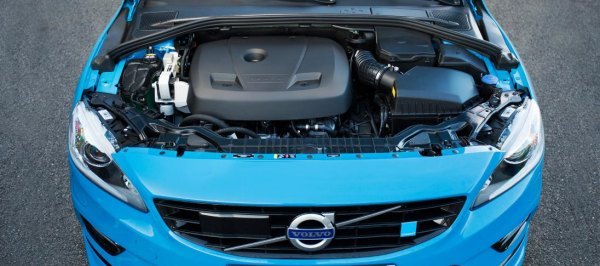
|
2 years ago Volvo surprised
us by launching a limited production run of S60 and V60 Polestar. They
were pretty good but hampered a little bit by an aging engine, i.e. a
3-liter straight-6 turbo supplied by its ex-parent company Ford. Having
finished the
production of 750 cars each, Polestar returned to the workshop and
started working on their updates. The result are these cars. They look
virtually the same as the original, but their 6-cylinder engines have
been replaced with the new
Drive-E family 2.0-liter 4-cylinders. Despite of reduced capacity and
cylinder
count, the new motor is equipped with both supercharger (which works at
low rev) and turbocharger (which takes over at high rev), and Polestar
improved it
further with new con-rods, camshafts, larger intake, larger exhaust
and, most important, a larger turbocharger which lifts boost pressure
to a maximum 2.0 bar. This liberates its output to 367 horsepower at
6000 rpm,
versus 350 hp at 5250 rpm of the old engine, although maximum torque
drops by 22 lbft to 347 lbft. Moreover, the 6-speed automatic gearbox
is upgraded to an 8-speed unit, supplied by Aisin again. As a
result, both cars
take 0.2 sec less than before to accelerate from 0-60 mph, while fuel
consumption and emission are cut by more than 20 percent. Doing more
for less, who doesn't want?
On the road, it is hard to tell whether the Drive-E engine is stronger
than the old 3-liter, but it does rev more eagerly towards top end,
especially from 6000 to 7000 rpm where the old engine simply gave up.
Both engines have a soft bottom-end
response compared with the best German turbocharged engines, partly
blame to the 1700 kg weight they need to haul, but the power delivery
is progressive and tractable. The Drive-E surges a little more
obviously from
3000 rpm as its big turbo intervenes. Even so, it is not to be called
explosive. Inevitably, the exhaust note is less musical than the
straight-6, and it loses a little bit smoothness. In my opinion, a
5-cylinder version of Drive-E could answer all these questions. Think
about it, Volvo.
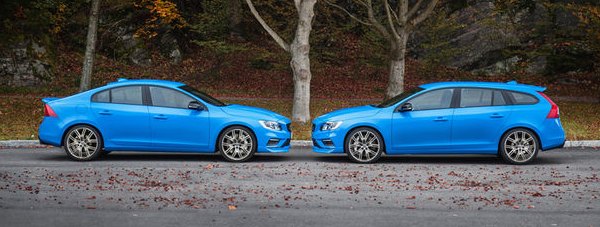
|
The 8-speed auto is more positive. Its gearchanges are smooth and quite
swift, a big improvement from the old 6-speeder.
One benefit brought by the smaller engine and new gearbox is that the
front axle is relieved by 24 kg. This makes the new car slightly keener
to turn. Less weight hanging at the nose also allows Polestar to soften
the front springs a little, thus improves low-speed ride. Other chassis
modifications are just carried over from the old cars, such as the
Ohlins adjustable dampers, Brembo brakes, Michelin Super Sport
245/35ZR20 tires and a specific-tuned Haldex 4WD system. The electric
power steering has been reprogrammed by Polestar, and it feels more
precise, if not more communicative.
Overall, the handling and ride are slightly improved from the old cars,
but its character remains intact – it is a good balance between control
and comfort. Certainly not as sporty as C63, M3 and RS4, but attractive
enough to steal sales from the semi-high-performance C43, 340i and S4.
The Polestar duo won’t steal too many sales though, because its
production is limited to 1500 cars each.
|
Verdict:     |
|
|
|
|
|
|
|
|
|
|
S60
D5
|
2010
|
| Front-engined,
FWD |
| Steel monocoque |
| Mainly steel |
| 4628 / 1865 / 1484 mm |
| 2776 mm |
Inline-5, diesel
|
| 2401 cc |
DOHC 20 valves
|
| Sequential twin-turbo |
| CDI |
205 hp (215 hp from 2011)
|
310 lbft
|
6-speed manual
|
F: strut
R: multi-link
|
-
|
| 215/55R16 |
1610 kg
|
| 146 mph (c) |
7.4 (c)
|
| - |
|
S60
T5
|
2011
|
| Front-engined,
FWD |
| Steel monocoque |
| Mainly steel |
| 4628 / 1865 / 1484 mm |
| 2776 mm |
Inline-4
|
| 1999 cc |
DOHC 16 valves, DVVT
|
| Turbo |
| DI |
240 hp
|
236 lbft
|
6-speed twin-clutch
|
F: strut
R: multi-link
|
-
|
| 215/50R17 |
-
|
| 143 mph (c) |
7.1 (c)
|
| - |
|
S60
T6
|
2010
|
| Front-engined,
4WD |
| Steel monocoque |
| Mainly steel |
| 4628 / 1865 / 1484 mm |
| 2776 mm |
Inline-6
|
| 2953 cc |
DOHC 24 valves
|
| Turbo |
| - |
304 hp
|
324 lbft
|
6-speed automatic
|
F: strut
R: multi-link
|
Adaptive damping
|
| 235/40WR18 |
1740 kg
|
| 155 mph (limited) |
6.2 (c) / 5.5* / 5.5**
|
13.4* / 13.9**
|
|
|
|
|
|
Performance
tested by: *C&D, **R&T
|
|
|
|
|
|
|
S60
R-Design
|
2011
|
| Front-engined,
4WD |
| Steel monocoque |
| Mainly steel |
| 4628 / 1865 / 1484 mm |
| 2776 mm |
Inline-6
|
| 2953 cc |
DOHC 24 valves
|
| Turbo |
| - |
325 hp / 5400 rpm
|
354 lbft / 3000 rpm
|
6-speed automatic
|
F: strut
R: multi-link
|
-
|
| 235/40WR18 |
1738 kg
|
| 155 mph (limited) |
5.5 (c) / 5.3**
|
13.0**
|
|
V60
Plug-in Hybrid
|
2013
|
| Front-engined,
e-4WD |
| Steel monocoque |
| Mainly steel |
| 4628 / 1865 / 1484 mm |
| 2776 mm |
Inline-5 diesel + electric motor
|
| 2401 cc |
DOHC 20 valves
|
| Sequential twin-turbo |
| CDI |
engine: 215 hp
motor: 67 hp
|
engine: 324 lbft
motor: 147 lbft
|
6-speed automatic
|
F: strut
R: multi-link
|
-
|
| 215/50R17 |
1955 kg
|
| 143 mph (c) |
6.1*
|
| 17.2* |
|
V60 D4
|
2013
|
| Front-engined,
FWD |
| Steel monocoque |
| Mainly steel |
| 4635 / 1865 / 1484 mm |
| 2776 mm |
Inline-4 diesel
|
| 1969 cc |
DOHC 16 valves
|
| Sequential twin-turbo |
| CDI |
181 hp
|
295 lbft
|
6-speed manual
|
F: strut
R: multi-link
|
-
|
| 215/50R17 |
1610 kg
|
143 mph (c)
|
7.0 (c) / 7.6*
|
20.4*
|
|
|
|
|
|
| Performance
tested by: *Autocar, **C&D |
|
|
|
|
|
|
V60 T5
|
2013
|
| Front-engined,
FWD |
| Steel monocoque |
| Mainly steel |
| 4635 / 1865 / 1484 mm |
| 2776 mm |
Inline-4
|
| 1969 cc |
DOHC 16 valves, DVVT
|
Turbo
|
| DI |
245 hp
|
258 lbft
|
8-speed automatic
|
F: strut
R: multi-link
|
Adaptive damping
|
| 215/50R17 |
1614 kg
|
| 143 mph (c) |
6.1 (c) / 6.2*
|
| 16.5* |
|
S60 T6
|
2013
|
| Front-engined,
FWD |
| Steel monocoque |
| Mainly steel |
| 4628 / 1865 / 1484 mm |
| 2776 mm |
Inline-4
|
| 1969 cc |
DOHC 16 valves, DVVT
|
Turbo + supercharger
|
| DI |
306 hp / 5700 rpm
|
295 lbft / 2100-4500 rpm
|
8-speed automatic
|
F: strut
R: multi-link
|
Adaptive damping
|
| 235/40WR18 |
1612 kg
|
| 143 mph (c) |
5.6 (c) / 5.4*
|
| 13.4* |
|
S60
(V60) Polestar
|
2013
|
| Front-engined,
4WD |
| Steel monocoque |
| Mainly steel |
| 4635 / 1865 / 1481 (1484) mm |
| 2776 mm |
Inline-6
|
| 2953 cc |
DOHC 24 valves
|
| Turbo |
| - |
350 hp / 5250 rpm
|
369 lbft / 3000-4750 rpm
|
6-speed automatic
|
F: strut
R: multi-link
|
-
|
| 245/35ZR20 |
1691 kg (1759 kg)
|
| 155 mph (limited) |
4.7 (c) / 4.5* (4.8 (c))
|
11.2*
|
|
|
|
|
|
Performance
tested by: *C&D
|
|
|
|
|
|
|
S60 (V60) Polestar 2.0
|
2016
|
| Front-engined,
4WD |
| Steel monocoque |
| Mainly steel |
| 4635 / 1865 / 1481 (1484) mm |
| 2776 mm |
Inline-4
|
| 1969 cc |
DOHC 16 valves, DVVT
|
Turbo + supercharger
|
| DI |
367 hp / 6000 rpm
|
347 lbft / 3100-5100 rpm
|
8-speed automatic
|
F: strut
R: multi-link
|
-
|
| 245/35ZR20 |
1676 kg (1721 kg)
|
| 155 mph (limited) |
4.5 (c) (4.6 (c) / 4.4*)
|
(10.9*)
|
|
|
|
|
|
|
|
Performance
tested by: *C&D
|
|
|
|
|
|
|
|
|
Copyright©
1997-2016
by Mark Wan @ AutoZine
|
|